Cigar Lighting -
How to properly fire one up!
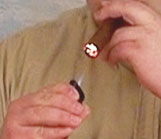 Evenly lighting the foot is the most critical part of cigar lighting. If a cigar is not lit evenly, it will not burn or taste properly. The best cigar lighting technique involves bringing the flame to the tobacco by gently drawing air through the cigar (a.k.a. puffing). While puffing, the cigar should be rotated over the flame to ensure the foot is evenly lit, without being charred.
Evenly lighting the foot is the most critical part of cigar lighting. If a cigar is not lit evenly, it will not burn or taste properly. The best cigar lighting technique involves bringing the flame to the tobacco by gently drawing air through the cigar (a.k.a. puffing). While puffing, the cigar should be rotated over the flame to ensure the foot is evenly lit, without being charred.Lighting Tips -
Your Do & Dont List
DO:
- Remove cellophane and any cedar or ribbons around the foot of the cigar.
- Cut the cigar properly
- When using a match, allow the sulfur/chemicals to burn off the match head before taking the flame to the tobacco.
- Hold the flame slightly off of the tobacco. Flame = 1/8 of an inch: Torch = 1/2 inch.
- Rotate the cigar to evenly light the foot.
- Puff on the cigar in order to draw the flame to the foot.
DON'T:
- Light or char the outside of the wrapper.
- Use a candle or liquid fuel lighter to light the cigar.
- Light the head.
- Lick the cigar: that is disgusting to watch and unnecessary if the cigar is properly humidified. The habit of licking a cigar was popular in the early 1900’s when proper humidity was more uncommon: low humidity may cause a wrapper to unravel.
The Perfect Cigar Cut
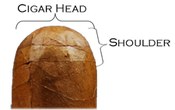

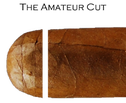
Regardless of the cutter being used (piercer, punch, guillotine, scissors), the main objective is to remove enough wrapper leaf for the cigar to draw. Many cigars will draw well with just a little wrapper removed, while others may need a larger hole.
Tobacconist Tip: If you want to avoid touching the shoulder and head of a customer's cigar, hold the cigar around the band and use a sharp cigar scissor to cut the cap. Sharp scissors will give you the most control and accuracy.
Images on right are (from top to bottom) head & shoulder, the perfect cut, and the amateur cut.
Cigar Preservation: Light and Heat
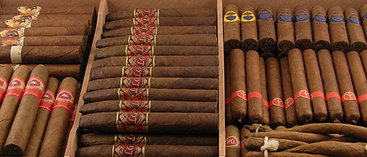 Cigars are best kept in low light or dark conditions. Overexposure to direct or indirect light will damage and fade cigar wrappers and encourage oil evaporation. In addition, light can create heat which will further damage the cigars. For these reasons, it is important to place your humidor away from direct sunlight where temperatures are as stable as possible.
Cigars are best kept in low light or dark conditions. Overexposure to direct or indirect light will damage and fade cigar wrappers and encourage oil evaporation. In addition, light can create heat which will further damage the cigars. For these reasons, it is important to place your humidor away from direct sunlight where temperatures are as stable as possible.Humidor Setup
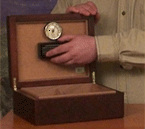 1. Unpack humidor. Inspect carefully and keep packaging materials in case you find a defect.
1. Unpack humidor. Inspect carefully and keep packaging materials in case you find a defect.2. Read enclosed instructions.
At this point you must decide whether to follow the manufacturer’s instructions or follow our humidor setup guidelines: we recommend the latter or a hybrid approach.
3. Attach humidifier and hygrometer.
Humidors with a wood lid usually include a hanging mechanism for humidifiers and/or hygrometers, i.e. magnets or velcro. The manufacturer provided adhesive on these tends to be the weakest link of the mechanism(s). Here are a few tips to help them function properly. Always stick the fasteners to a dry surface. Allow the fasteners to adhere to the dry surface for 24 hours before hanging anything on them. Feel free to use a higher grade of fastener like industrial Velcro or a stronger glue. If you use glue, be sure to allow fumes to dissipate before closing the lid.
4. Glass top humidors may have a non-adhesive rubber gasket to affix the hygrometer. Be sure to press the edges of the hygrometer when inserting it so you don’t break the glass. The humidifier usually comes with a stand so adhesive is not necessary.
5. Once humidifiers and hygrometers are securely fastened you can begin humidifying the box. DO NOT WIPE THE INSIDE OF THE BOX WITH WATER!!!!! This can cause the wood to become hyper-saturated, expand, and damage the joints or seal of the box*. Instead, fill the humidifier with distilled water every day for the first week until you reach the desired humidity (68-72%). This will allow the wood to absorb moisture slowly. This process is often referred to as "seasoning", not because spices or flavors are added, but because the humidor's environment is acclimated to suit the cigars.
6. Once you have reached your optimal humidity, the humidor is ready for cigars. The humidifier should be refilled every 2-3 weeks or as needed to maintain proper humidity.
HOT TIP: Remember that humidifiers hanging from the top of the box will dissipate moisture downward, with the help of gravity. Hygrometer readings at the top of the humidor may not reflect humidity conditions at the bottom of the box. Use your hands to check the condition of your cigars regularly. If needed, rotate your collection or tweak the location of your humidifier to achieve optimal results.
*Many manufacturers and Tobacconists may suggest you 'wipe down' the inside of your humidor with a clean sponge and distilled water. This helps expedite the seasoning (water absorption) proces; but it also increases the likelihood that the wood will saturate too quickly and damage the joints and/or lid. We always recommend the slower, more patient approach of allowing the wood to absorb water naturally. This is often a difficult 'sell' to customers who want to fill their humidors immediately; but, like great cigars, certain things should not be rushed. Not saturating/sponging is the safest approach.
Hygrometer Calibration
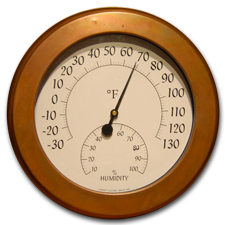 A hygrometer is the instrument that measures humidity. The two main types of hygrometers are analog and digital. While methods for calibrating/adjusting hygrometers varies between products, the following methods will help you establish an accurate benchmark.
A hygrometer is the instrument that measures humidity. The two main types of hygrometers are analog and digital. While methods for calibrating/adjusting hygrometers varies between products, the following methods will help you establish an accurate benchmark.Checking Hygrometer Accuracy:
Table Salt Method
Mix 1/2 cup table salt and 1/4 cup water in a vessel, then place in an airtight container (i.e., ziptop bag). After 24 hours, at room temperature, the humidity in the bag will be 75% (RH) - table salt will seek equilibrium at 75 RH. Adjust your hygrometer accordingly, or just remember what +/- to factor in.
Damp Towel Method (less accurate)
Wrap your hygrometer in a damp (but not dripping) towel for 20 minutes. Afterwards, the humidity in the towel will be 98% (RH).
TOUCH & FEEL
While it is helpful to use a hygrometer when quickly checking the condition of your cigars, there is no substitute for your sense of touch. Every connoisseur knows that cigars must be felt to ascertain their condition and disposition. A cigar should feel silky and smooth to the touch. A well conditioned cigar should yield slightly when gently squeezed between your fingers. The wrapper should not crack or make a sound. When you release the depression, the cigar should slowly regain its shape.
Lighter Maintenance
Butane lighters can be tricky to operate properly. Lighter mechanics and the challenges of dealing with pressurized gas require a little extra care and attention. The most important part of maintaining a reliable butane lighter is to fill it properly and keep the flame head (or burner) clean.
First, adjust the flame dial to the lowest possible setting.
The next and most important step to properly refilling a butane lighter is to PURGE it. Purging gets rid of excess oxygen which remains in the gas tank. All refillable butane lighters have a valve on the bottom that works like a tire valve. Before refilling the lighter, you must push the "tire" like valve IN to purge/evacuate the excess gas and oxygen. The excess oxygen and residual gas left inside will seep out and make a "hissing" sound. By using a match stick or small screwdriver, you can repeatedly push the valve in until you cannot hear any more air escaping. PURGING will empty the lighter's reservoir tank and ensure a clean and undiluted refill.
To FILL your lighter with butane, first turn the lighter and butane upside down. Then gently mate the butane can with the lighter valve. Push the butane can down for approximately fifteen seconds or until the lighter will not accept any more gas.
In addition to proper filling, it is imperative to keep the flame head/burner CLEAN and free of ash and debris. Regular cleaning can be accomplished with an air burst from your mouth or a compressed air duster. When using a compressed air duster, make sure you don't ignite the lighter as the contents of the air duster may be flammable and dangerous.
First, adjust the flame dial to the lowest possible setting.
The next and most important step to properly refilling a butane lighter is to PURGE it. Purging gets rid of excess oxygen which remains in the gas tank. All refillable butane lighters have a valve on the bottom that works like a tire valve. Before refilling the lighter, you must push the "tire" like valve IN to purge/evacuate the excess gas and oxygen. The excess oxygen and residual gas left inside will seep out and make a "hissing" sound. By using a match stick or small screwdriver, you can repeatedly push the valve in until you cannot hear any more air escaping. PURGING will empty the lighter's reservoir tank and ensure a clean and undiluted refill.
To FILL your lighter with butane, first turn the lighter and butane upside down. Then gently mate the butane can with the lighter valve. Push the butane can down for approximately fifteen seconds or until the lighter will not accept any more gas.
In addition to proper filling, it is imperative to keep the flame head/burner CLEAN and free of ash and debris. Regular cleaning can be accomplished with an air burst from your mouth or a compressed air duster. When using a compressed air duster, make sure you don't ignite the lighter as the contents of the air duster may be flammable and dangerous.
The information listed on this page was created in part from Tobacconist University.
